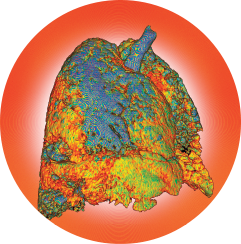
K H FUNG / Science Source
A recent proof-of-concept study to evaluate nuclear imaging in interstitial lung disease (ILD) concludes it is feasible to study ILD subtypes using this technology to visualize specific molecular processes of ILD. The process has important potential applications for the development of targeted molecular therapies.1
ILD is an umbrella term for a group of heterogeneous lung diseases, of which the two most common are idiopathic pulmonary fibrosis and ILD that presents in the context of connective tissue disorders, such as systemic sclerosis. The common end stage of ILD, pulmonary fibrosis, is a chronic, progressive and ultimately fatal lung disease with poor prognosis and high mortality rates.
SPECT Scans
Using molecular biology techniques, the team of researchers, based at University Hospital Zurich and the Center for Radiopharmaceutical Sciences (CRS) in Switzerland, conducted analyses of lung tissue specimens with severely damaged lung architecture obtained through lung transplantation in patients with ILD, along with samples from bleomycin (BLM)-challenged mice and respective controls.2 They performed single photon emission computed tomography (SPECT) scans, a nuclear imaging methodology, to visualize the pulmonary expression of two molecules implicated in the pathophysiology of ILD, integrin alpha-v beta-3 (αvβ3) and somatostatin receptor 2.
Specific pulmonary accumulation of radiotracers was assessed by in vivo and ex vivo scans at several time intervals in ILD. Expression of the two molecules was found to be substantially increased in patients with ILD regardless of subtype, as well as in the BLM-treated mice, with stage-specific overexpression by rates three- to fourfold over controls.
Nuclear imaging produces images from radiation following the introduction of a small amount of a radioactive tracer, typically by injection into a vein. The radiotracer travels through the area being examined and emits energy in the form of gamma rays, which are used to create images of the diseased site in the body. SPECT and positron emission tomography scans are the most common nuclear imaging modalities used in routine diagnostics. These procedures are noninvasive and typically painless medical aids in the diagnosis and evaluation of various medical conditions.
Nuclear imaging has the advantage of truly capturing and visualizing pathophysiology compared with high-resolution computed tomography and magnetic resonance imaging, which reflect anatomy, says the new study’s corresponding author, Britta Maurer, MD, senior consultant rheumatologist and group leader at the Center of Experimental Rheumatology at University Hospital Zurich. She also holds the Prof. Max Cloetta Research Position at the center. Nuclear imaging provides unique information that often cannot be obtained using other imaging procedures and offers the potential to identify molecular disease subtypes.
No Precision in Targeting ILD Treatments

Dr. Maurer
“The situation we face with ILD is that there are no validated biomarkers for disease staging, prediction of disease progression or drug response. Right now we can’t match the individual patient to the right therapy,” Dr. Maurer tells The Rheumatologist. “These patients are heterogeneous, with different targets of action. We have no way of predicting which patient will benefit from which treatment.” This requires managing ILD on a trial-and-error basis. “We need tools to define the best therapy for the individual patient,” she says.
Marco Matucci-Cerinic, director of the Division of Medicine and Rheumatology at the University of Florence, Italy, and current chair of the European League Against Rheumatism Scleroderma Trial and Research Group, says the Swiss preclinical proof-of-concept study offers new insights and opens new avenues for research. These will need to be validated and cross-checked in larger patient populations with patient stratification according to subsets of lung involvement.
“This is novel research. For the first time, particular receptors have been linked definitively and correlated to the clinical picture of lung involvement and the pathology of lung tissue in interstitial pneumonia. These receptors are very important to us,” Dr. Matucci-Cerinic explains.
This concept can identify pathophysiologic key molecules and, thus, eventually point to targeted approaches to treatment. “This research could have translation in clinical practice within the next few years and on how the illness is perceived,” he continues.
“I would also like to focus our interest on somatostatin receptors. These are expressed primarily in the nervous system but are also seen in immune cells like leukocytes. That raises the question of how much the peripheral nervous system may be involved in the pathogenesis of ILD in connective tissue disease,” Dr. Matucci-Cerinic says.
Next Steps
Dr. Maurer says her research group, together with the co-principal investigator at CRS, Cristina Mueller, PhD, aims to launch a clinical trial in 2019 using nuclear imaging, looking at targets beyond those used in this study, integrin αvβ3 and the somatostatin receptor. “We are also thinking of the folate receptor subtype β, which is expressed on activated macrophages. These other targeted radiotracers are available today. What’s needed is the proof of concept,” she says.
She expresses hope for advances in the treatment of ILD. “With so much research elucidating the pathophysiology of this disease, we can expect the approval of specific therapies in the next two or three years. Several compounds are now being tested in phase 2 or 3 trials. It’s now time to think about developing diagnostic tools that will allow us to substratify patients for individualized treatment,” Dr. Maurer says.
“I think medical imaging and nuclear medicine, in particular, have a lot of potential that we are only starting to explore,” Dr. Maurer states. Compared with lung biopsies, these are non-invasive methodologies, and they don’t require high doses of radiation. She is confident that within the next five years, subtyping patients based on predicted drug responses will be possible, which will take us one step closer to precision medicine.
Larry Beresford is a medical journalist in Oakland, Calif.
References
- Schniering J, Benešová M, Brunner M, et al. Visualisation of interstitial lung disease by molecular imaging of integrin αvβ3 and somatostatin receptor 2. Ann Rheum Dis. 2019 Feb;78(2):218–227.
- Moeller A, Ask K, Warburton D, et al. The bleomycin animal model: A useful tool to investigate treatment options for idiopathic pulmonary fibrosis? Int J Biochem Cell Biol. 2008;40(3):362–382.
